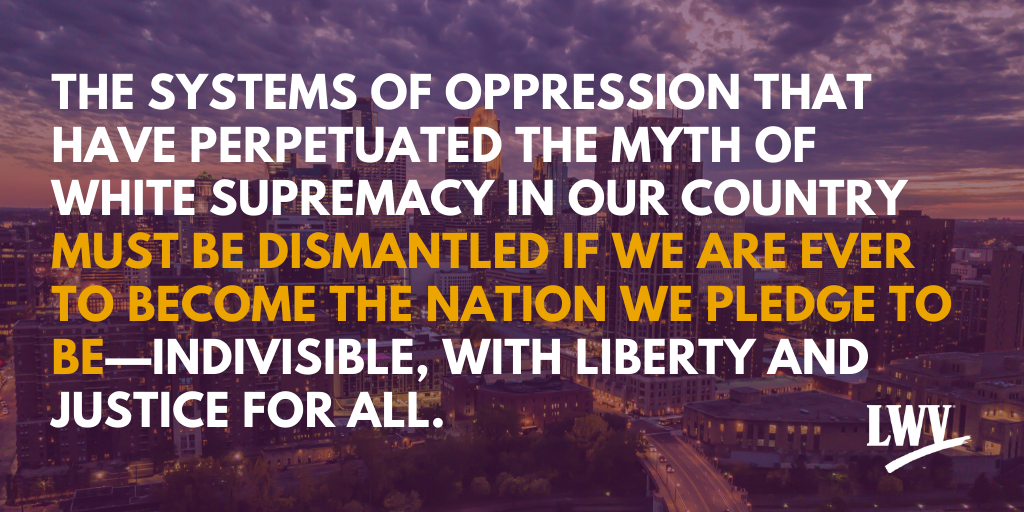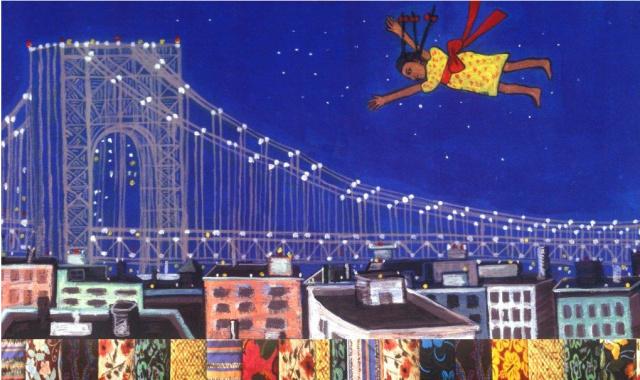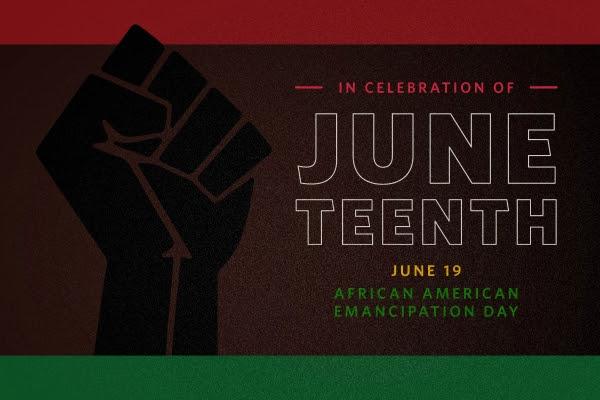
The League of Women Voters of Kent is committed to the core values of diversity, equity and inclusion. We will continue to grow a diverse organization of shared power that considers and values all perspectives expressed when making decisions. We are creating a community of respect, celebration, and empowerment which enables all people to influence government through active participation in the political process.
PRACTICES
Opportunity to contribute: We commit to building and maintaining a diverse and inclusive environment that creates opportunities for meaningful participation from members of the community.
Teamwork: We commit to collaborative, diverse teams that value and actively include all input and ideas which will enrich he work of the organization and ensure its longevity.
Making a difference: We believe a powerful way to make a positive difference in the community is by having a diverse membership. We work to incorporate the spirit of equity in our positions, priorities and programs.
Leadership: We commit to practicing leadership and embracing the development of leaders grounded the core values of diversity, equity and inclusion.
Click here for the Diversity, Equity and Inclusion Policy of the League of Women Voters of the U.S.
The Journey so far...
The Diversity program for LWV Kent has two subcommittees: Community Engagement, headed by Fay Ann Sebaly, and the Values Alignment Committee, headed by Amie Cajka. Member Dr. Alfreda Brown, who is the vice president of the KSU Office of Diversity, Equity and Inclusion, guided our steps as the convener, faciltiator and strategist for the program. The new head of the LWV Kent Diversity Program is Sally Saltzman.
Community Engagement members have been connecting with diverse groups in the community to learn, listen, collaborate and share information about the League. The VAL looks at our League tools, events and processes, such as the website, candidate forums and membership, to see if there are barriers to achieving a more diverse membership and a voice in the community in support of diversity.
Speak UP! To Racists Comments Workshop
Member Christie Anderson engaged attendees in an interactive workshop in April 2019 on responding to racists comments in a way that will increase the possibility of a meaningful conversation rather than raising defenses. This three hour workshop will support the Kent League's practice of inclusion. Christie shared tips on identifying and responding to microaggressions in constructive ways by using the “Teaching Tolerance” materials developed by the Southern Poverty Law Center.
If you are interested in joining the efforts, email the committees at lwvkent [at] gmail.com.
Some resources League members have been reviewing:
“The Danger of a Single Story" Chimamanda Ngozi Adichie
Ted Talks: Our lives, our cultures, are composed of many overlapping stories. Novelist Chimamanda Adichie tells the story of how she found her authentic cultural voice -- and warns that if we hear only a single story about another person or country, we risk a critical misunderstanding.
BOOK LISTS
A recent full committee meeting of the Diversity Committee generated discussion about pulling together a book list of works by authors who explore diversity through their writing. Contributors are Judith Makens, Iris Meltzer and Christie Anderson.
Send your recommendations to lwvkent [at] gmail.com.
ADULT BOOK LIST
Judith described these are "postcolonial" books that members might be interested in:
The Wide Sargasso Sea by Jean Rhys
Things Fall Apart by Chinua Achebe
The Brief Wondrous Life of Oscar Wao by Junot Diaz
The God of Small Things by Arundhati Roy
Season of Migration to the North by Tayeb Salih
Suggested by Iris:
A link to 48 Books By Women and Nonbinary Authors of Color to Read in 2019
A link to 28 Brilliant Books by Black Authors Are the Standouts in What Was a Stellar Year in Black Literature

Tar Beach by Faith Ringgold, reknown quilter and author
CHILDREN'S/YOUTH BOOKS
Christie sent these links and lists:
Cooperative Children's Book Center, School of Education, University of Wisconsin
50 Multicultural Books Every Child Should Know
http://ccbc.education.wisc.edu/books/detailListBooks.asp?idBookLists=42
The Guardian
Diverse voices: the 50 best culturally diverse children's books
https://www.theguardian.com/childrens-books-site/2014/oct/13/50-best-culturally-diverse-
childrens-books?CMP=twt_gu
School Library Journal
Culturally Diverse Books Selected by SLJ’s Review Editors
https://www.slj.com/?detailStory=culturally-diverse-books-selected-by-sljs-review-editors
Where To Find Diverse Books
https://diversebooks.org/resources/where-to-find-diverse-books/
Here are 14 children’s picture books exploring race and racism from the Institute for Human Education. The Institute for Humane Education (IHE) teaches about the interconnected and pressing issues that impact all life – humans, other animals, and the earth we share – and provides individuals of all ages with the tools to be solutionaries for a better world.
1. The Soccer Fence: A Story of Friendship, Hope and Apartheid in South Africa by Phil Bildner 2014. Grades 1-4. Hector loves soccer and dreams of playing with the (white) boys from another part of Johannesburg, but apartheid and racism are too prevalent. When, over the years, Nelson Mandela is released from prison and elected president, and then the beloved Bufana Bufana national soccer team wins the African Cup of Nations finals, Hector and one of the white boys bond over the soccer win and forge a new friendship.
2. Chocolate Me! by Taye Diggs 2011. Grades PreK-2. A young boy who is teased and questioned about being different (“chocolate me”) wishes for different skin, hair, and a different nose, but his mother helps him see himself in a special way and to love what he
sees when he looks in the mirror.
3. Amazing Grace by Mary Hoffman 1991. Grades PreK-2. Grace has a wonderful imagination and lots of experience acting out exciting adventures and playing roles. So when her teacher announces that the class will put on “Peter Pan” Grace wants to play the lead. Grace doubts herself when classmates tell her she can’t play that role because she’s a girl and because she’s black, but her mother’s and grandmother’s love and support remind her that she can do and be anything.
4. Grandpa, Is Everything Black Bad? by Sandy Lynne Holman 1998. Grades 1-4. Montsho comes to his grandfather to find out: “Is everything black bad?” Montsho mentions “black cat,” “black sheep,” “black eye,” and black villains on TV as evidence. Montsho’s grandfather shows him why black is “one of the most beautiful colors in the world” by telling him about his African heritage.
5. Skin Again by Bell Hooks 2004. Grades K-3. A brief call to look beyond the skin we’re in to who we are inside: “The skin I’m in/is just a covering./If you want to know who I am/you have got to come inside/and open your heart way wide.”
6. The Colors of Us by Karen Katz 1999. Grades PreK-2. Lena’s mother is teaching her about mixing colors and takes Lena on a tour of the neighborhood to see all the different shades of brown that make up the skin colors of their friends, family, and neighbors.
7. All the Colors We Are: The Story of How We Got Our Skin Color by Katie Kissinger 2014. Grades PreK-3. This bilingual (English/Spanish) book, with bright photographs, offers children a simple but accurate and effective explanation of the three ways we get our skin color (genetics, melanin, the sun) and emphasizes that our skin color is just one “of the many ways people are special and different from each other.” The end of the book includes a couple of follow-up activities.
8. Let’s Talk About Race by Julius Lester 2005. Grades 1-5. Lester uses his own story to emphasize that we all have stories, and that race is only one small part of our stories.
9. Goin’ Someplace Special by Patricia C. McKissack 2001. Grades 1-5. In 1950s Nashville, for the first time, Tricia Ann’s grandmother gives her permission to go to her “someplace special” on her own, reminding her to “hold yo’ head up and act like you b’long to somebody.” Along the way Tricia Ann faces bigotry, hatred, and discrimination. She feels nearly ready to give up on getting to her “someplace special” until she meets a woman who gives her renewed courage and determination, telling her, “You are somebody, a human being — no better, no worse than anybody else in this world.” When Tricia Ann finally gets to her “someplace special,” she smiles at the sign that says “Public Library: All Are Welcome.”
10. Busing Brewster by Richard Michelson 2010. Grades 1-4. Brewster is (mainly) looking forward to first grade. But when his mother tells him and his brother Bryan that they’re going to be bused to Central, which is mainly a white school, the boys are trepidatious. When the bus arrives on the first day, there are white adult protestors shouting and even throwing rocks. Things don’t get better inside when a white student starts an incident, and Brewster, Bryan, and the boy Bryan calls “Freckle-face” end up in detention all day in the library. With the words of his mother in his head (“Maybe you’ll be president someday, Brewster.”), Brewster is befriended by the librarian, who begins to teach him how to read, and Bryan and “Freckle-face” end up bonding.
11. Mr. Lincoln’s Way by Patricia Polacco 2001. Grades 1-4. Mr. Lincoln is “the coolest principal in the whole world,” but he struggles to reach “Mean Gene,” a student who bullies and uses racial epithets learned from his bigoted father. When Mr. Lincoln discovers
Gene’s interest in birds, the two of them end up creating a habitat in the school’s atrium that becomes a bird paradise, including for a pair of nesting Mallards. And Mr. Lincoln is able to help Gene find kindness for other people as he feels kindness for the birds.
12. Desmond and the Very Mean Word by Archbishop Desmond Tutu and Douglas Carlton Abrams 2013. Grades 1-5. When a group of boys shout “a very mean word” at a young Desmond, he wants to hurt them back, rather than take the advice of his mentor, Father Trevor, and forgive them. “When you forgive someone, you free yourself from what they have said or done. It’s like magic.” When Desmond gets a chance for retribution, it doesn’t help, and he eventually learns the power of forgiveness.
13. The Skin You Live In by Michael Tyler 2005. Grades PreK-3. This rhyming poem celebrates the diversity in our skin and all the things we do in our skin: “… the skin you have fun in; the skin that you run in; the skin that you hop, skip and jump in the sun in ….”
14. The Other Side by Jacqueline Woodson 2001. Grades K-4. Clover and Annie live on separate sides of a fence that divides the “black side” and “white side.” Both girls have been told not to cross the fence, but no one said anything about sitting on top of it.
Links from Iris:
A link to Black Boy Fly: 53 Children’s Books Centering and Celebrating the Humanity of Black Boys
A link to 26 books to support conversations on race, racism and resistance

In order to honor Juneteenth as a time of reflection, below is a suggested reading list provided by The Royall House and Slave Quarters.
Foundation
Many Thousands Gone, Ira Berlin
This book focuses on the first two hundred years of slavery in the “new world.” Professor Berlin divides the colonies into four distinct regions and examines the development of slavery in each of these regions. He explains the important concept of and differences between “societies with slaves” and “slave societies.”
Slavery in the Age of Reason: Archaeology at a New England Farm, Alexandra Chan
This book is crucial to understanding how the Royall’s and the people that they enslaved lived. It was written by about the archeological dig done on our grounds.
Ten Hills Farm: The Forgotten History of Slavery in the North, C. S. Manegold
This book chronicles the history of the estate known as Ten Hills Farm first owned by John Winthrop and subsequently purchased by Isaac Royall Sr.
New England Bound: Slavery and Colonization in Early America, Wendy Warren
This is a well researched account of slavery in early New England emphasizing its roots in commerce and social history. It also includes Native American Slavery
Commerce and Profit
The Half that has Never Been Told: Slavery and the Making of American Capitalism, Edward E Baptist
Both broad and deep, this book examines the financial system created and sustained by slavery. It explains the national complicity in maintaining the system of slavery.
Empire of Cotton, Sven Beckert
This book presents global history through the lens of the propagation, commercial trade and subsequent industrialization of cotton. It does not focus exclusively on slavery.
Complicity: How the North Promoted, Prolonged and Profited from Slavery, Anne Farrow
This book is more narrowly focused on the role of the northern states in the Slave trade and how some prominent New England families made their fortunes during the period leading up to the Civil War.
Social Fabric
Disowning Slavery: Gradual Emancipation and Race in New England 1780-1860, Joanne Pope Melish
This book examines the lives of black people as they became free. It discusses their social networks, religious expression, and efforts at improving their situation.
Black Yankees, The Development of an Afro-American Subculture in Eighteenth-Century New England, William Dillon Piersen
This book examines the intersectionality of African and Yankee culture. It examines how Africans took traditions from many tribes and their adapted them to Yankee culture. It also examines how they influenced Yankee culture.
The Negro in Colonial New England, Lorenzo Johnston Greene
This book was published in 1942 so its language is dated. I found it interesting from the perspective of how this history was viewed in 1942.
The Other Brahmins: Boston’s Black Upperclass, 1750-1950, Adelaide M Cromwell
This is an interesting sociological study. It examines the development of class in the Black community and similarities and differences to the majority class structure.
How We Got Here
The New Jim Crow, Michelle Alexander
This book traces the history of control over black bodies from slavery through mass incarceration.
Ebony and Ivy: Race, Slavery and the Troubled History of America’s Universities, Craig Steven Wilder
This book examines the role that the Academy played in providing theories and arguments, both supposedly scientific and otherwise, to support the view of the inferiority of black people.
The Color of Law: A Forgotten History of How Our Government Segregated America, Richard Rothstein
This book makes a convincing argument that de jure segregation, the laws and policies passed by local, state and federal governments that promoted the discriminatory patterns that persist today.
Black Wealth/ White Wealth: A New Perspective on Racial Inequality, Thomas M. Shapiro and Melvin L. Oliver
An examination of the legacy of slavery’s impact on the ability of black people to create, accumulate and generationally pass down wealth.